Birds with red legs and feet stand out when flying or walking. Their red legs may be an adaptation to attract the attention of their species when breeding or the result of diet-based pigmentation.
Small and large birds of the world come with various shades of red legs. While not all birds have red legs, those that do tend to stand out to humans as they often have contrasting plumage.
Some birds with red legs are native to North America. Others aren’t even visible to humans as they live in remote areas such as in the case of The Arctic Tern.
Here are some of the most common birds that have red legs which may or may not be easily visible to humans with their distinctive traits.
Table of Contents
1. Red-footed Booby
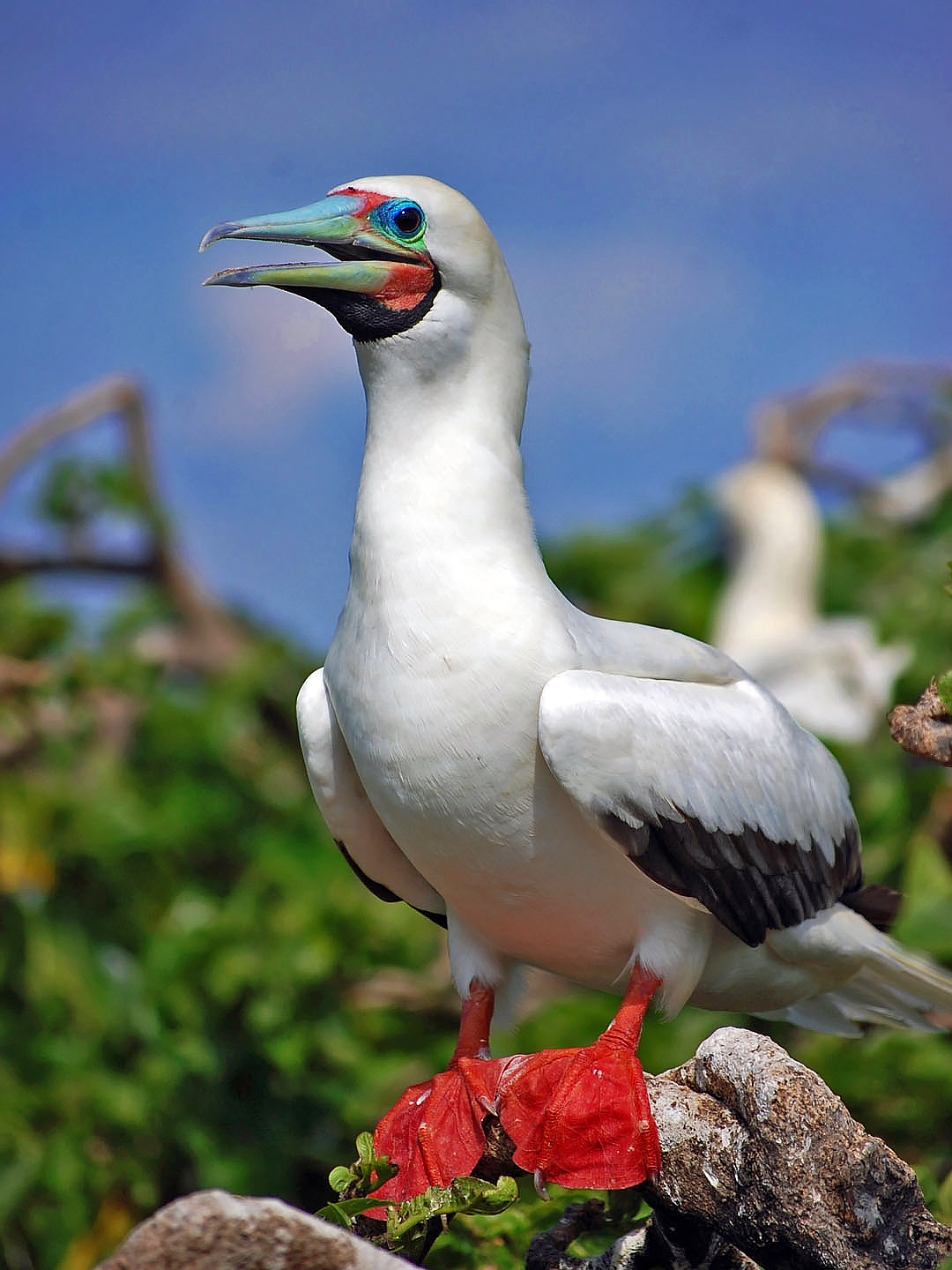
Red-footed Booby birds (Sula sula) are named after their red feet. A vivid red color is specific to these large birds.
Mostly found in tropical areas, Red-footed Booby is a bird that prefers small islands and coastal areas.
With a known ability to fly, these birds may struggle to walk due to their large size.
There are 3 Red-footed Booby subspecies. They show different plumage coloring but all share the same red legs.
These birds come in white and black plumage in most cases. Some morphs of the species show brown and black plumage.
All of its subspecies are spotted in colonies. They move along the tropics and over oceans, rarely being spotted outside of their breeding season.
Known to fly long distances, Red-footed Booby eats fish which they take out of seas and oceans.
Distribution – tropical regions of The Pacific, Atlantic, and Indian Ocean
2. Pigeon Guillemot

Red legs and a red mouth are specific to the black or black and white Pigeon Guillemot (Cepphus columba). This species has dark red legs and dark red inner mouth coloring.
The bird grows to around 15 inches and it is found around the Northern Pacific, particularly in coastal areas.
It lives in small groups and it prefers to nest on cliffs or on other elevated points from where it cannot become an easy target for predators.
This bird comes out for food early in the morning but it may also be highly active during the day.
Since it lives in cool areas of the world, Pigeon Guillemots prefer to migrate South during the winter.
Mostly feeding on fish, Pigeon Guillemot birds dive a few feet underwater for food.
Distribution – Northern Pacific
3. Black Guillemot

Similar to Pigeon Guillemot, The Black Guillemot (Cepphus grylle) has a black color with red legs and a red inner mouth color.
This species has a black bill and its coloring might only be brighter in the case of mostly brown juveniles.
Birds of this species are also found in Northern Pacific but their range expands across The Atlantic Ocean.
They are found in coastal areas of Iceland, the United Kingdom, and Northern Europe.
Much of their activity is unknown to humans as they rarely travel inland. This species builds nests on cliffs and around the coast.
A known bird that eats fish, The Black Guillemot dives for fish it also feeds on its young.
While smaller than other Guillemots, The Black Guillemot grows to a size of up to 12 inches.
It can be found in its Northern range through the seasons expect the wintertime when it migrates Southwards.
Distribution – coastal areas of Alaska, Northeastern Canada, Greenland, Iceland, United Kingdom, Sweden, Norway, Russia
4. Red-footed Falcon

A common predator in steppe temperate climates, the male Red-footed Falcon (Falco vespertinus) has red legs.
This species is a predator with a diverse diet including reptiles, rodents, mammals, bugs, insects, and other small birds.
It lives in the steppe regions of Russia and the Eastern parts of Europe from early spring to late fall.
It then migrates across Africa to settle in the Southern parts of the continent where it overwinters before making the journey back to Asia and Europe for breeding.
While some estimates show there are almost 1 million Red-footed Falcons left in the wilderness, other data suggests these birds are starting to become extinct in some of their traditional regions due to loss of habitat.
Bulgaria is one of the countries where Red-footed Falcons breed but where their populations are in decline.
Distribution – Asia, Middle East, Europe, Africa
5. Roseate Spoonbill

Pink to red legs are characteristic of The Roseate Spoonbill (Platalea ajaja). This species also has red plumage and a white neck and head.
Brighter coloring is specific to the young Roseate Spoonbill.
Once close to extinction in North America, the species now has stable numbers along The Gulf of Mexico and South America.
Some Northern populations are seen as the preferred nesting sights across Florida change. These birds are even spotted along the Eastern US coast on some years.
Its red color is impacted by its diet as it feeds on red crustaceans.
The birds walk through shallow water along the coast moving their bills and looking for food in the water.
The exact lifespan of the species is unknown but these birds are believed to survive more than a decade.
Distribution – Texas, Florida, Mexico, Colombia, Brazil, Uruguay
6. American White Ibis
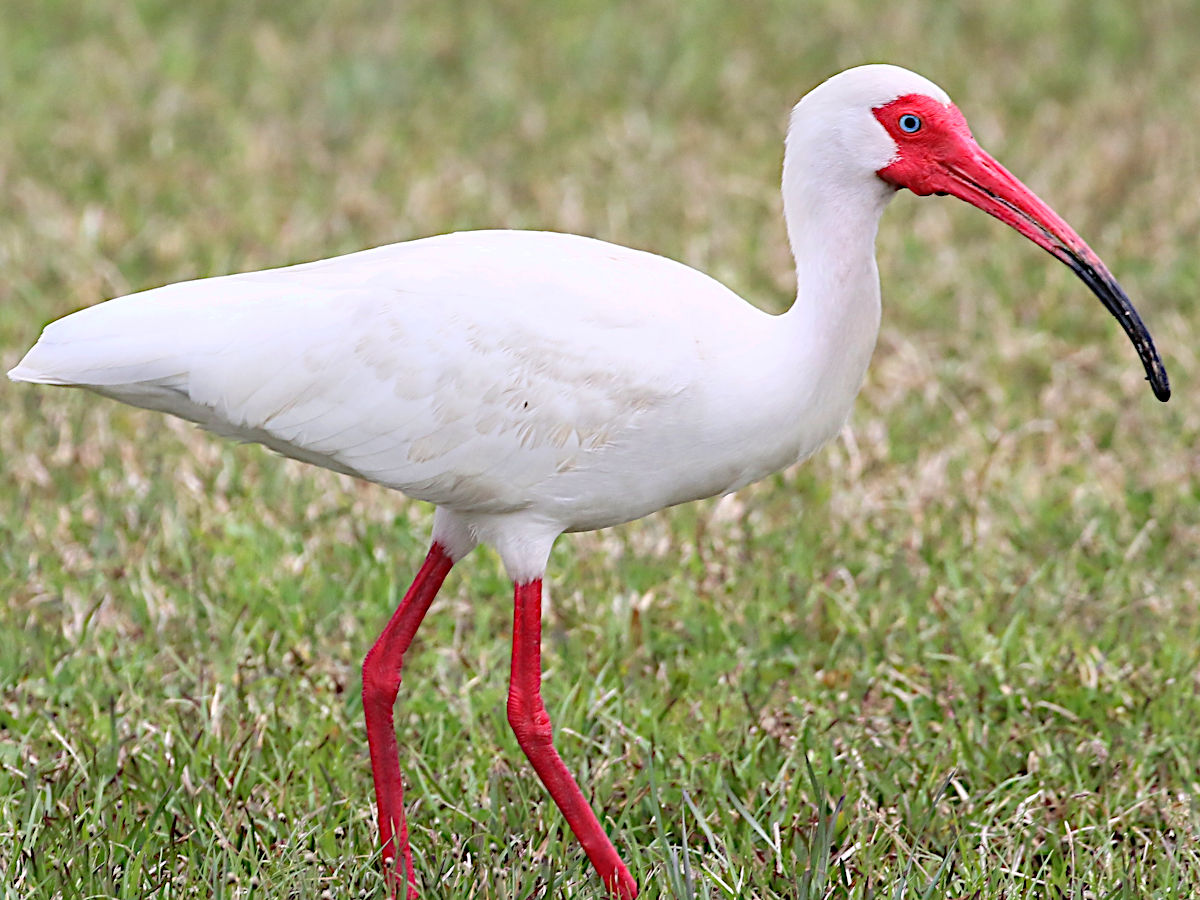
Red legs, a long red bill, and white plumage make up the contrasting appearance of The American White Ibis (Eudocimus albus).
This species is native to Central and North American territories along the coast and in The Gulf of Mexico.
It only feeds on what it can find in the water, particularly on crustaceans.
American White Ibis is also among the birds to show inner-breed conflict, particularly between males and females.
Low food availability prompts males to steal food from females.
This is an important aspect of their behavior as The American White Ibis has been shown to spend almost all hours of the day looking for food.
Distribution – The Gulf of Mexico, West Indies, Central America, South America
7. Scarlet Ibis

The bright red color and pale red legs represent the dominating appearance traits of The Scarlet Ibis (Eudocimus ruber).
This species mostly lives in small groups but it may also live in large colonies in regions such as Brazil during the mating period.
It chooses various coastal areas to live in, mostly far from human settlements.
These birds also build nests in vegetation around coastal areas but also further inland.
Much of their appearance is impacted by their age.
Juveniles of the species are black and slowly turn red by first going through a gray phase.
Much of their lives are spent looking for food in muddy areas or dense vegetation. Scarab beetles are among the most important bugs these birds eat.
Distribution – Brazil, Venezuela, Trinidad and Tobago, Colombia
8. Egyptian Goose

A species native to Egypt and Africa, The Egyptian Goose (Alopochen aegyptiaca) shows bright red legs.
This species spends most of its life on the ground, as a terrestrial type of African goose.
A widespread habitat is specific to these geese. They are present across most sub-Saharan habitats in areas with dense vegetation, along the water, and in woodlands.
It feeds on different small aquatic vertebrates in its early days and slowly moves on to seeds and grasses into adulthood.
Often nesting in hollow trees, these geese show highly aggressive behavior towards humans but especially among themselves.
The breeding period marks the most aggressive period of the year for the geese.
Distribution – Egypt and sub-Saharan countries
9. Chukar

Ober 14 subspecies of Chukar (Alectoris chukar) exist around the world. These birds are native to Europe and The Middle East.
Chukar populations are also established in California and North America as game species.
Known to grow up to a size of 14 inches, Chukars have red legs and mostly gray plumage.
They live at various altitudes and show adaptability to arid climates, coastal areas, and high-elevation terrains such as those in New Zealand.
Birds of this species have few natural predators. Depending on their region, their young may be predated by Golden eagles.
Distribution – Southern Europe, Middle East, Pakistan, Northern India, California
10. Black-headed Gull

Much of the appearance of The Black-headed Gulls (Chroicocephalus ridibundus) depends on gender and the period of the year.
This species changes colors as it goes into the breeding season in the case of the males.
The male Black-headed Gull has white bellies, a white neck, a black head, and gray wings contrasted by red legs in the summer when it breeds.
Outside of the breeding season, the male has a white head and orange legs, together with gray wings and a black tail tip.
Like other types of gulls, The Black-head Gull is known to have a varied diet, marked by eating whatever it can find.
This includes insects, fish, worms, and scarp food it can find in inhabited areas.
Distribution – Eastern North America, Europe
11. Black-necked Stilt

A fan of wetlands, The Black-necked Stilt (Himantopus mexicanus) is one of the species with pink to red legs.
This bird grows to a size between 13 and 15 inches and features a white belly. Its neck and head are both black and white.
Black-necked Stilts are found in an expansive habitat from the Southern parts of The United States to South America.
A strong presence is tied to regions of Florida, California, and Oregon. These are regions where the species also breed.
Its North American populations are in slight decline over the past few decades.
Much of this decline is tied to changes in its habitat and excessive urbanization.
Distribution – Oregon, California, Texas, Florida, Central America, West Indies, South America
12. Bonaparte’s Gull

Orange-red legs are seen on the contrasting black and white Bonaparte’s Gull (Chroicocephalus philadelphia).
This North American gull has a black head when breeding, to attract the attention of females. Its head is mostly white when not breeding.
Gulls of this species move along the entire North American Continent, up to Alaska.
Much of their movements across the continent are marked by their breeding migratory needs.
Bonaparte’s Gulls move towards the coast or to the regions of The Great Lakes in the case of the gulls in Canada.
Like most types of gulls, Bonaparte’s Gulls have a varied and opportunistic diet.
A small preference towards insects has been documented for the breeding period of these gulls.
Distribution – Alaska, Canada, and The United States.
13. Red-legged Kittiwake

Vivid red legs are characteristic of The Red-legged Kittiwake (Rissa brevirostris). This is a mostly unknown species to humans due to its Arctic habitat.
Birds of the species live in the Northern Pacific, close to The Arctic.
It’s where they live in coastal areas and out at sea. They are a constant presence in The Gulf of Alaska during the winter.
Its summers are the best time to spot the species which invade coastal areas for breeding.
Red-legged Kittiwakes are adapted to their cool climates and feed on small fish.
Distribution – Alaska, Subarctic Pacific
14. Snail Kite

Orange-red legs are seen on Snail Kites (Rostrhamus sociabilis). Males birds have a dark gray to black main color and red eyes.
The Snail Kites juvenile has brown and white plumage and it looks like a falcon.
Birds of this species are mostly found in Florida, in The US. Its numbers are declining here due to a loss of habitat and food.
Unlike other predators, Snail Kites only eat Florida Apple Snails in the case of Southern Florida populations.
Crayfish is also a common food for these birds.
This species is present in higher numbers across South America. It prefers to breed in the tropical range of the continent.
Distribution – Florida, Cuba, Mexico, Colombia, Venezuela, Brazil
15. White-tipped Dove
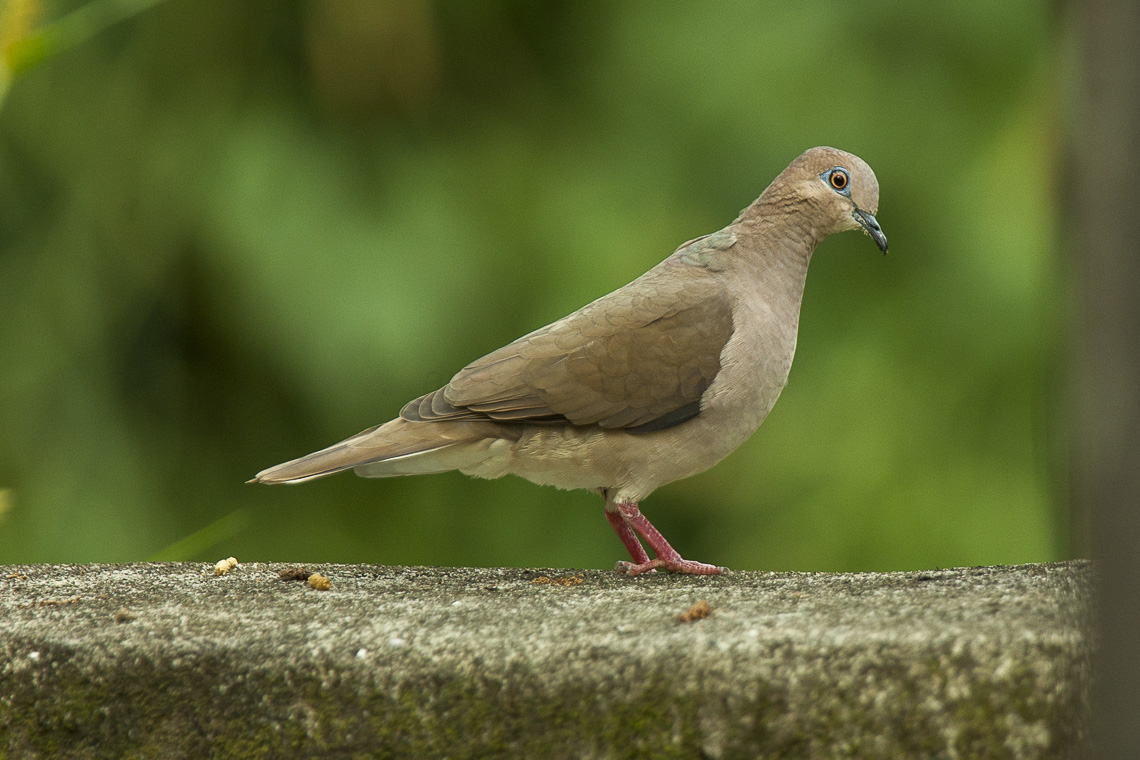
Red legs are characteristic of the White-tipped Dove (Leptotila verreauxi). This species has gray plumage with red marks along the neck and lateral red stripes on its head.
Parks, gardens, and woodlands are its main habitats.
This species feeds on what it can find on the ground, including seeds and small insects.
White-tipped Doves are known to communicate using basic sounds. They can even make alarming sounds when a potential predator approaches.
Distribution – Central America, South America
16. Wood Thrush

Pink-red legs contrast the white and brown appearance of The Wood Thrush (Hylocichla mustelina).
Native to the Eastern parts of The United States and Mexico, this bird is mostly seen in the summer when it breeds.
Wood Thrush has a white belly and neck with contrasting dark brown and black spots.
The common nature of the species makes it an official bird in various municipalities and states such as The District of Colombia.
Birds of this species feed on different types of insects and seeds. They can also eat young salamanders and other types of prey along the woodlands of North America.
At the same time, their eggs and young are often food for other predators.
Blue Jays are among its most important predators, together with raccoons.
Distribution – Southeastern Canada, Eastern United States, Mexico, Honduras, Guatemala, Panama
17. Mourning Dove

Red or orange-red legs are seen on Mourning Doves (Zenaida macroura). These are some of the most common doves in North America and some of the most numerous birds on the continent.
High and very high breeding rates ensure there are millions of Mourning Doves in The United States alone.
Some variation exists between the Mourning Doves in the East compared to those in the West.
This mainly regards the length and color of the beak.
Mourning Doves are birds that focus on eating seeds. They rarely eat other types of food.
The high number of Mourning Doves also makes them viable prey for larger birds such as hawks.
Male birds of this species are known to have distinctive call sounds which may sometimes be taken from owl sounds.
This species has a growing presence in the South, of Central America. However, Mourning Doves rarely breed in Central America.
Distribution – Canada’s central provinces, throughout The US, Central America
18. European Starling

The European Starling (Sturnus vulgaris) is one of the species with red legs that have been introduced around the world.
Birds of this species are banned from import in certain regions of the world such as Australia due to their impact on crops.
Seen in different subspecies with metallic black, green, gray, or brown colors, these birds can also have red legs.
Their role is beneficial and detrimental. They can eat bugs and worms but they can also invade urban areas and crops.
Some states list them as official pests.
The European Starling is now a species present across North America where it travels into Northern Canada during the summer.
A beneficial role can be attributed to these birds in agriculture. They can eat different legume-eating bugs on crops.
On the other hand, The European Starling may also eat different types of fruits and destroy entire crops.
Distribution – Europe, US, Canada, Russia, India, Australia
19. Rock Pigeon
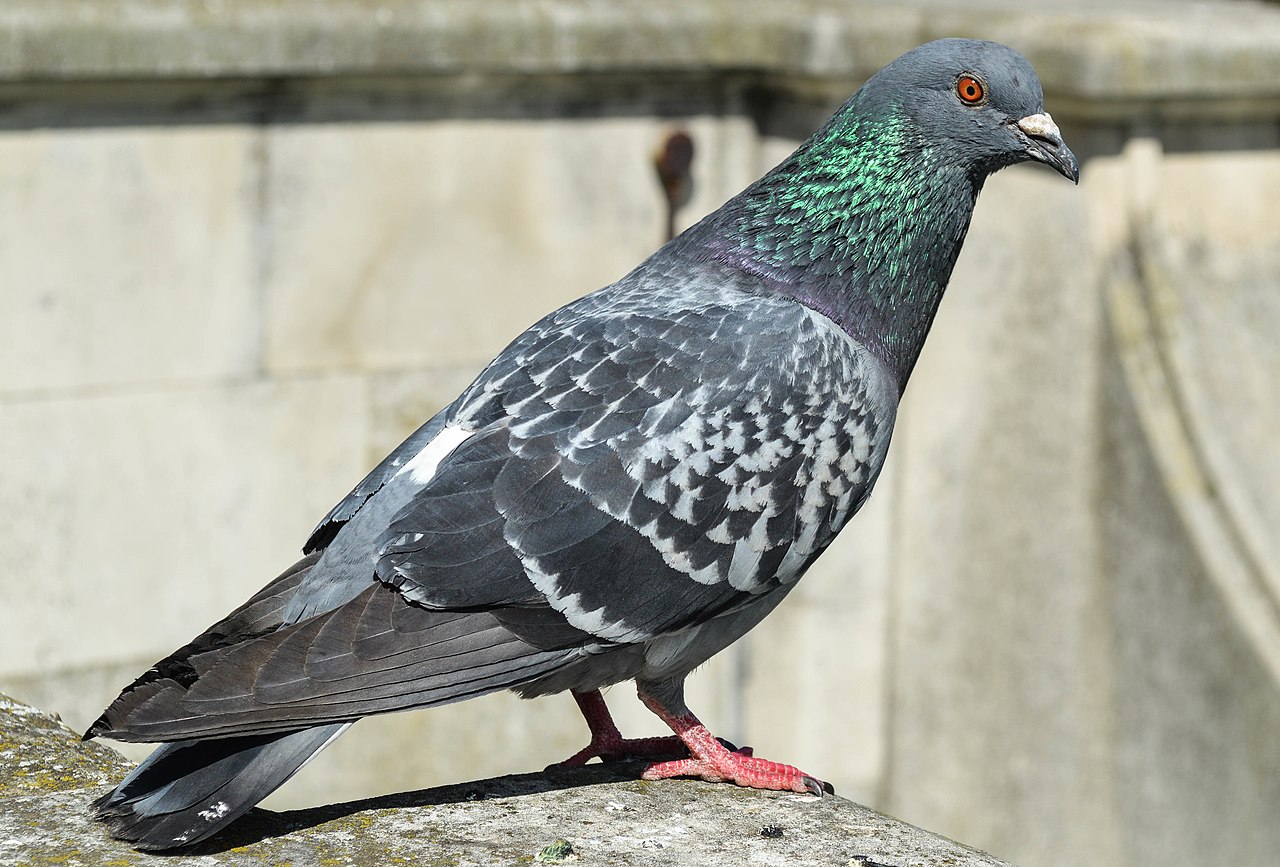
Rock Pigeons (Columba livia) are some of the most widespread birds with red legs around the world. Initially found in Europe, these pigeons made it to North America, South America, Africa, and Asia by ships.
Various means of transport of goods and people have led to its rapid multiplication around the world.
Various subspecies are also noted for these widespread pigeons.
Small coloring differences may exist between the various Rock Pigeon subspecies around the world.
For example, its African subspecies that live along the River Nile are known to have a paler appearance while those in The Arabian Peninsula appear darker.
While it seems these pigeons may eat anything, they prefer seeds to other types of food.
Birds of the species normally live in large and very large flocks.
They might move along in pairs during the breeding period.
Rock Pigeons are also widely common as domesticated birds. Mixed with other birds, these pigeons may spread bird flu such as avian influenza.
Distribution – Northern Europe, Southern Europe, North and South Africa, Middle East, Southern Asia, North America, South America, Australia
20. Black-bellied Whistling-Duck
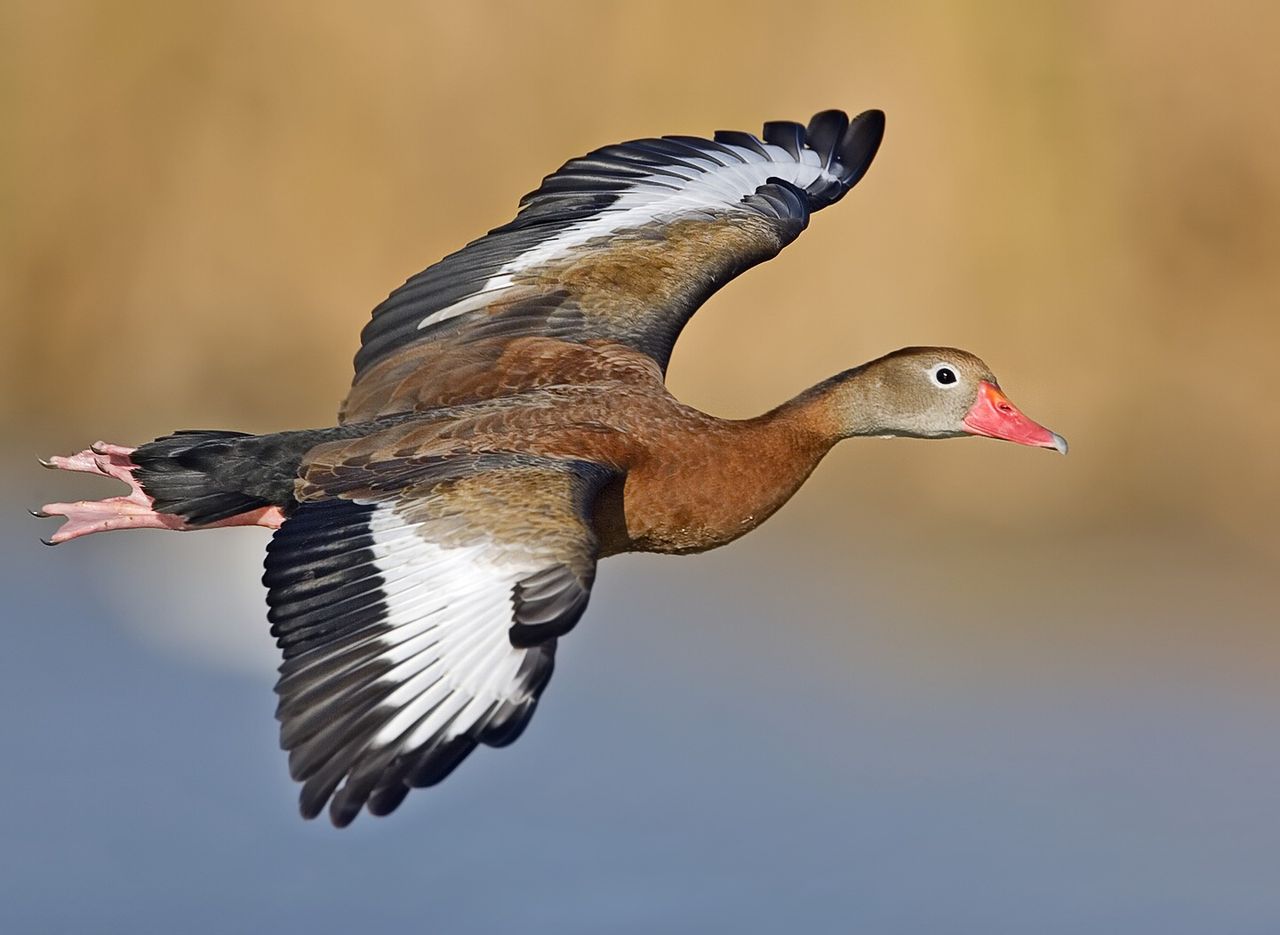
Dark pink to red legs and beaks are specific to The Black-bellied Whistling-Duck (Dendrocygna autumnalis).
Present in a few subspecies across America, Black-bellied Whistling-Ducks have a colorful appearance but are rarely seen as they’re mostly nocturnal.
While they don’t overlook an eating opportunity during the day, these types of birds feed at night.
They eat plants, seeds, and different types of insects or aquatic spiders.
Submerged plants are also a common food for these ducks for their soft texture and nutritional value.
The breeding habits of Black-bellied Whistling-Ducks are highly different from those of most ducks.
For example, the species shows parental care roles both for males and females. The mated male and female remain together for years.
They even take turns taking care of the eggs in the incubation stages.
A common docile manner towards other ducks of the same species is also seen in the species. These ducks are always seen in large flocks.
Distribution – North America, South America, Mexico
21. Forster’s Tern

While its plumage color may vary by season, Forster’s Terns (Sterna forsteri) have red feet. This species shows a white head during most of the year and a black top of the head during the breeding season.
The belly is white while the wings of the species are black.
Forster’s Terns are birds that feed on various types of small fish.
These birds live in small or large flocks and often move or act together in front of danger.
For example, they may attack a nest intruder together, improving their chances of driving intruders away.
This species is native to North and Central America where it can live and breed around marshes.
Distribution – Canada, US, Mexico
22. Arctic Tern

Vivid red legs and a similarly-colored beak are characteristic of The Arctic Tern (Sterna paradisaea). This is a species dominated by white and gray nuances.
A contrasting appearance is specific to these birds which live around The Arctic.
They then migrate Southwards to the Antarctic, being the animals with the longest migration routes in the world.
This species moves along South America and Africa to guide itself from The Arctic to The Antarctic.
With a size of up to 14 inches, The Arctic Tern is seen across coastal areas in flocks.
Some of its preferred coastal habitats include those in Iceland.
This bird shows highly aggressive behavior toward other species and even toward humans.
Most of its attacks are tied to a perceived threat approaching its nest.
Birds of this species still have many natural predators such as gulls, which eat or steal their eggs.
A lower number of small fish is believed to be one of the main reasons the numbers of Arctic Tern are diminishing.
Even so, there are more than a couple of million Arctic Terns around the world.
Distribution – Northern Europe, North America, Northern Asia
23. ʻIʻiwi

A red beak, red legs, and a red body are characteristic of an iconic Hawaiian bird, The ‘I’iwi (Drepanis coccinea).
This species is only found in the forests at high elevations on the main Hawaiian Islands. ‘I’iwi is only seen at elevations of over 4.000 feet.
This bird can also be seen at lower elevations when it migrates to the base of its mountainous regions.
‘I’wis can also be heard as these birds have a characteristic song. The whistling sounds of the species stand out from other birds’ whistling sounds as they are often compared to squeaks.
The numbers of these birds are diminishing and while endangered, the bird populations of the species are still stable.
Possible deforestation is one of the main concerns regarding the future of ‘I’iwi in Hwaii.
This species is often seen as food by various mammals.
Distribution – Hawaii
24. Little Gull

Little Gulls (Hydrocoloeus minutus) are another black and white gull species to have vivid red legs.
This species is found around freshwater marshes in Europe and Asia. It has been building small colonies in North America over the past few years.
These are seen in Canada where the species may migrate to overwinter.
Little Gulls in Western Europe are more likely to migrate to Canada than those in Asia.
As its name implies, The Little Gull is a small gull species. As the smallest of all gulls, Little Gulls only grow to a size of up to 12 inches.
The diet of Little Gulls is comprised of small insects they catch on the surface of the water or in flight.
Distribution – Western Europe, Northern Europe, Southern Europe, Asia
25. Red-legged Honeycreeper

Both male and female Red-legged Honeycreepers (Cyanerpes cyaneus) have vivid red legs.
These are small colorful birds with different appearances based on their sexes. Males are dark blue and black while females are light green and olive.
Central America and South America are the distribution areas of the species where the bird is found in the largest flocks.
A steady number of Red-legged Honeycreeper birds are also found in Southern Florida.
These birds start to breed in the spring and females start to build a nest during this period. These nests are always placed above the ground.
Specific calls are also attributed to the species in this breeding period. These are high-pitched calls.
Distribution – Florida, Mexico, Guatemala, Nicaragua, Cuba, Venezuela, Colombia, Ecuador, Brazil, Bolivia